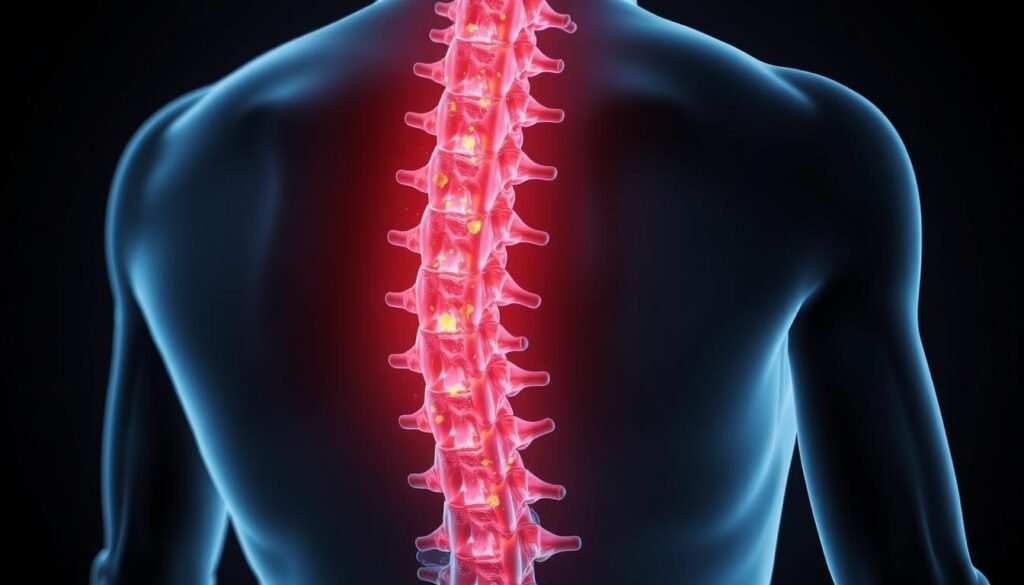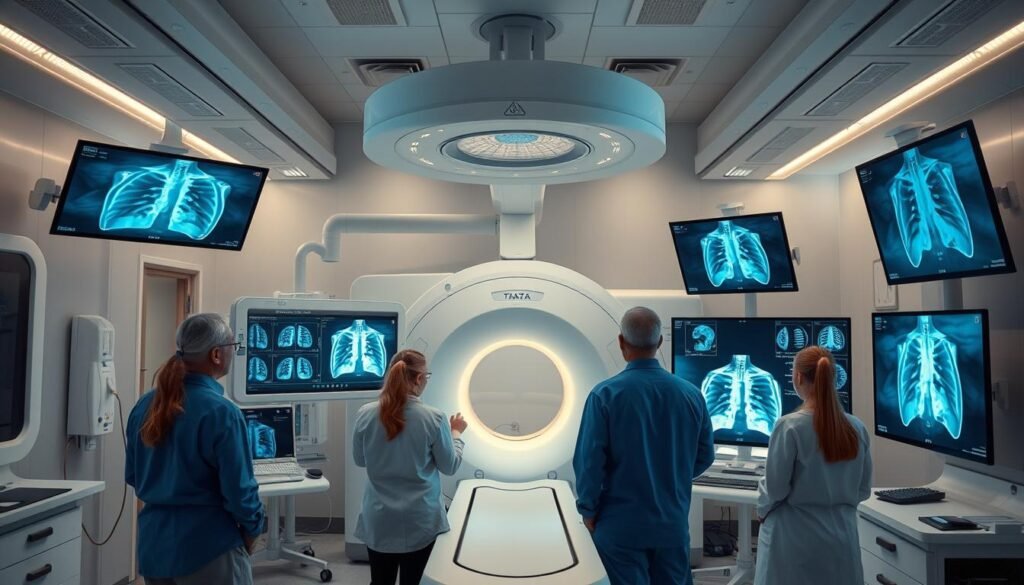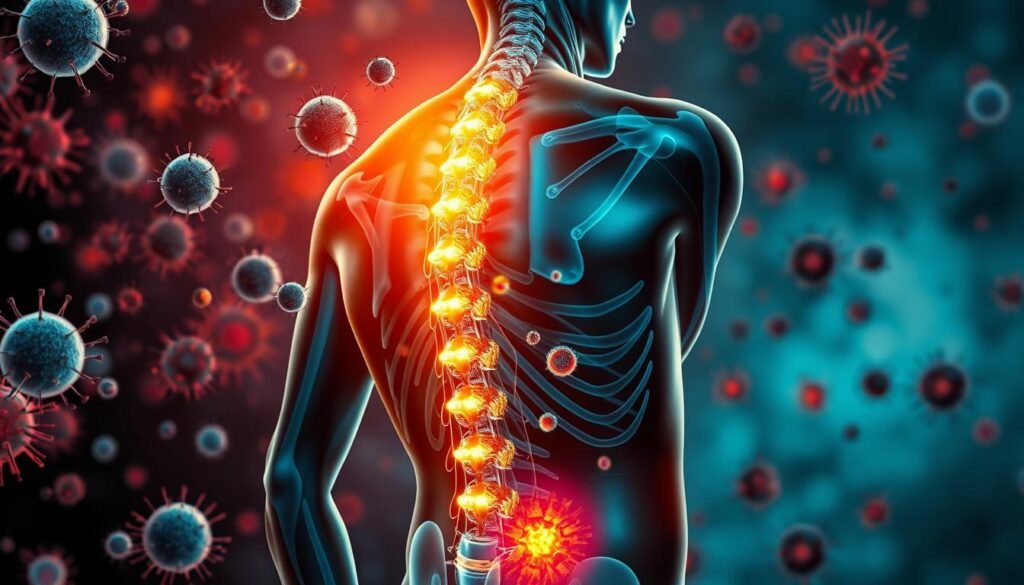About 25% of those diagnosed with lung cancer have reported back pain. This fact is concerning, mainly because back pain is often dismissed as minor. Yet, back pain, together with pain in the shoulders and neck, can hint at lung cancer. It is crucial to identify these signs early. Doing so can greatly influence treatment and outcomes.
Back pain could be one of the first hints of lung cancer. For some, like Heather, back pain leads to discovering they have stage 4 lung cancer. It’s clear that the link between back pain and lung cancer is significant. It underscores the need to pay attention to our lung health and its effect on our overall health.
Key Takeaways
- About 25% of lung cancer patients experience back pain.
- Common symptoms of lung cancer may include persistent cough and unexplained weight loss.
- Early detection of lung cancer can provide life-lengthening treatment options.
- Back pain may worsen as lung cancer progresses.
- Diagnostic imaging such as X-rays and CT scans are crucial for assessing back pain in suspected lung cancer cases.
- Prompt medical consultation is critical if back pain is accompanied by other lung cancer symptoms.
Understanding Back Pain
Back pain is a complex issue that can stem from various causes. While some think it’s from minor injuries or muscle strain, truly understanding back pain causes can shed light on serious conditions, like cancer. Knowing what contributes to back pain is key to identifying it early.
Common Causes of Back Pain
People may experience back pain for several reasons. These include:
- Muscle or ligament strains from heavy lifting or awkward movements
- Degenerative conditions, such as arthritis, leading to stiffness and pain
- Injuries from accidents or sports involvement
- Structural issues like scoliosis or kyphosis, impacting spinal alignment
Sometimes, back pain hints at more serious issues like spinal cancer or other cancers that spread to the spine, causing pain. Notably, about 25 percent of those with lung cancer experience back pain as a first symptom.
How Back Pain is Typically Perceived
Many see back pain as a normal part of life, blaming it on too much physical work or a lack of activity. Pain can be mild or severe, sharp or dull. If the pain doesn’t go away or gets worse, it’s a sign to see a doctor.
Symptoms like a constant cough or trouble breathing may accompany the pain. These signs are vital to notice as they might indicate more serious issues, including possible lung cancer.
Recognizing Symptoms of Lung Cancer
Knowing the symptoms of lung cancer is key for early diagnosis and effective treatment. Lung cancer signs are often similar to other health issues, like back pain. It’s crucial to spot them early. Here are the main symptoms and others to watch for.
Primary Symptoms to Watch For
- Persistent cough: About half of those with lung cancer have a cough that gets worse over time.
- Coughing up blood (hemoptysis): Around 20% of lung cancer patients face this scary symptom.
- Shortness of breath: Many have trouble breathing due to reduced lung function.
- Chest pain or discomfort: Chest pain might mean lung cancer or other serious conditions.
Other Related Symptoms
Other symptoms may hint at lung cancer or its impact on your health:
- Unexplained weight loss: This happens to 35% to 75% of people before they are diagnosed.
- Fatigue: Feeling tired all the time could be a warning sign.
- Wheezing: This suggests trouble with air passages.
- Recurring infections: Often having respiratory infections might be a clue to lung cancer.
- Hoarseness: A change in voice or speaking difficulty can occur.
Understanding these symptoms helps individuals and doctors act early. It’s extra important when these signs appear with back pain.
Back Pain as a Symptom of Lung Cancer
Back pain as a symptom of lung cancer can show up in many ways. It’s often a challenge for those it affects. Knowing how this pain appears is key for early detection and treatment.
How Back Pain Can Present
Some people feel a dull ache in their muscles or sharp pains. The pain may get worse at night or when breathing deeply. About 1 in every 4 people with lung cancer have reported back pain after diagnosis.
This pain can happen when lung tumors press on nerves or if cancer spreads to the spine. It might come with weight loss, feeling very tired, or coughing up blood.
Differences Between Lung Cancer-related Pain and Other Pain
It’s important to know how lung cancer pain differs from regular back pain. Usual back pain can get better with rest or therapy. But, pain from lung cancer stays and may get worse.
One key difference is that lung cancer pain can come with high calcium levels in the blood. Understanding these differences helps spot lung cancer early and plan out treatment.
| Characteristic | Lung Cancer-related Pain | Typical Back Pain |
|---|---|---|
| Onset | Persistent | May improve with movement |
| Duration | Worsens at night | Varies; may improve with rest |
| Associated Symptoms | Weight loss, fatigue, coughing blood | Muscle stiffness, localized tension |
| Response to Treatments | May require advanced medical interventions | Often responds to physical therapy |
Why Does Lung Cancer Cause Back Pain?
Lung cancer and back pain are connected in several ways. About 25% of people with lung cancer experience back pain first. This pain can come from cancer spreading to nearby areas.
Mechanisms Behind the Pain
Pain from lung cancer can get complex. Tumors growing can push on nerves and tissues, causing hurt. High calcium levels from cancer make pain worse. Knowing why helps treat the pain better.
Spinal Cord Involvement in Lung Cancer
Spinal cord issues are critical in lung cancer. Between 30 to 70 percent of cancer patients see cancer move to their spine. Lung cancer often causes this. Cancer in the spine leads to bad pain and other serious problems. It’s important to catch and treat spinal cord issues early.

| Condition | Impact on Back Pain |
|---|---|
| Lung Cancer Metastasis | May lead to pressure on spinal nerves, causing pain. |
| Malignant Spinal Cord Compression | Involves infiltration of vertebrae, leading to severe symptoms. |
| High Calcium Levels | Can induce additional pain sensations. |
| Scoliosis | May restrict lung size and contribute to back discomfort. |
| Pulmonary Embolism | Can cause chest and back pain, indicating a medical emergency. |
Identifying the Red Flags
It’s crucial to recognize warning signs that might mean lung cancer for early help. Some symptoms can alert people to get medical advice fast. Knowing these signs can make a big difference in treatment.
Key Symptoms Indicating Lung Cancer
Look out for signs that may point to lung cancer, like:
- Persistent cough that gets worse
- Chest pain, not linked to breathing problems
- Unexplained weight loss
- Getting out of breath easily
- Back pain that feels different or very bad
These lung cancer symptoms are not the usual and need checking with your health status.
Signs That Require Immediate Medical Attention
Some symptoms mean you should see a doctor right away for lung cancer checks. These include:
- Back pain at rest or that’s worse at night
- Pain that usual painkillers don’t ease
- Problems controlling bladder or bowels
- Very weak arms or legs
Dealing with these urgent signs fast can help start treatments sooner, increasing chances of success. For deeper details, check out lung cancer detection guidelines for more information.
Diagnostic Methods for Back Pain
Understanding how to diagnose back pain is crucial, especially when it might be related to lung cancer. This includes using diagnostic imaging to spot potential tumors or spine damage. It’s also vital to carry out the right tests to confirm if lung cancer is causing the back pain.
Role of Diagnostic Imaging
Diagnostic imaging methods, such as X-rays, CT scans, and MRIs, are key in finding the cause of back pain. These techniques let doctors see inside the body to check for any issues. This is especially useful for catching signs of lung cancer affecting the spine.

Tests Used to Confirm Lung Cancer
Apart from diagnostic imaging, doctors also run tests to confirm lung cancer. This includes blood tests to look for tumor markers or check calcium levels. Combining these tests with imaging helps give a full view of a patient’s health. Getting accurate test results is essential for planning the best treatment.
| Diagnostic Method | Description | Purpose |
|---|---|---|
| X-Ray | Common imaging technique using radiation to visualize structures | Initial assessment for abnormalities in the spine and chest |
| CT Scan | Detailed imaging using X-rays taken from multiple angles | Better visualization of tumors and metastasis |
| MRI | Uses magnetic fields to create detailed images of soft tissues | Identification of spinal cord compression or damage |
| PET Scan | Imaging test that helps see metabolic activity | Assessment of cancer spread and tumor activity |
| Blood Tests | Lab tests to check for tumor markers and calcium levels | Confirmation of lung cancer diagnosis and monitoring |
Treatment Options for Back Pain Related to Lung Cancer
People with back pain from lung cancer have many treatment choices. These options can make managing pain easier. Healthcare experts work with patients to find the best mix of treatments. This might include medicine and other methods to improve life.
Medication Strategies for Pain Management
Starting with medication is common for pain relief. Simple painkillers like acetaminophen help with mild pain. But for stronger pain, doctors may prescribe opioids. These drugs aim directly at the pain to reduce it.
- Opioids: Administered based on pain levels, they play a crucial role in managing severe pain.
- Nonsteroidal anti-inflammatory drugs (NSAIDs): Helps reduce inflammation, aiding in pain relief.
- Adjuvant medications: Antidepressants and anticonvulsants are sometimes included to manage chronic pain symptoms.
Non-Medical Treatments and Palliative Care
Along with medicine, non-medical treatments help too. Physical therapy and acupuncture improve well-being. They can help patients move better and ease pain.
Palliative care focuses on a better quality of life. It helps with physical, emotional, and psychological needs. This care lessens pain, increases comfort, and supports patients fully.
Lung Cancer and Its Metastatic Nature
Lung cancer is a huge health issue, mainly because it can spread to other body parts. This spreading, known as metastasis, causes many problems for patients. It’s especially tough when the cancer reaches the spine, causing severe back pain.
Understanding Cancer Metastasis
Cancer metastasis is when cancer cells move from their original spot to new areas. For lung cancer, this means it can reach the liver, brain, and even bones. This spread makes symptoms worse, affecting the patient’s life.
People with metastatic lung cancer deal with tiredness, pain, and swelling. For those treating lung cancer, knowing about metastasis is key to help manage it.
How It Affects Back Pain Severity
Spinal metastasis from lung cancer can make back pain much worse. This intense pain complicates treatment. Back pain from metastatic lung cancer might cause fractures or press on the spinal cord.
To tackle this pain, doctors use a mix of treatments. These can include painkillers, radiation, and even relaxation methods.

| Metastatic Site | Common Symptoms | Treatment Approaches |
|---|---|---|
| Spine | Severe back pain, possible fractures | Pain management, radiotherapy, surgical interventions |
| Liver | Fatigue, swelling, jaundice | Palliative care, medication for symptoms |
| Brain | Headaches, neurological deficits | Radiation therapy, corticosteroids |
| Other Bones | Bone pain, mobility issues | Bisphosphonates, pain relief medications |
For more info on lung cancer and what it can do, check out this source.
Importance of Early Detection
Finding lung cancer early is key for good treatment results. The sooner we spot it, the better the odds of beating it. Sadly, people often miss back pain as a clue of lung cancer. This means delays in getting checked and starting treatment.
Outcomes of Early Lung Cancer Diagnosis
Only up to 30 percent of lung cancers get found early. It’s crucial we spread the word about symptoms like back pain. Doing so can lead more people to get checked early.
Getting diagnosed early can save lives. It means lower death rates and longer lives, especially for those at high risk.
How Back Pain Influences Awareness and Diagnosis
Knowing how back pain and lung cancer are linked can lead to early detection. It makes finding the disease early a priority. If you have ongoing back pain and a history of smoking, see a doctor. They might suggest a check for lung cancer.
Tools like COPD and lung cancer symptoms are key for early spotting. They help catch the disease early for better treatment.
Conclusion
Knowing how back pain and lung cancer are connected is key for catching it early and treating it right. Often, people might think back pain isn’t serious. But, it could be a sign of something like lung cancer. Spotting this early can help get the right help fast.
Lung cancer is one of the top causes of cancer deaths in the United States. It makes up 28% of all cancer deaths. This shows why it’s so important to know the symptoms, like back pain. When both doctors and patients can spot these signs early, it makes a big difference. It leads to faster diagnoses and better ways to manage pain.
Treatments that include medicine and sometimes surgery can make life better for those affected. Research keeps moving forward, looking for early signs of lung cancer, such as back pain. Fighting this widespread disease starts with recognizing these early warnings.